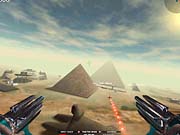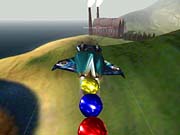Real.com is probably best known for its popular RealPlayer streaming media software, but the site is also taking part in the burgeoning field of Web-based and downloadable games. In Clusterball, one of the featured games, you pilot nimble futuristic ships through outdoor arenas, trying to gather as many colored balls as quickly as possible from platforms dotting the landscape. As you pick up balls, they dangle in a string from the back of your craft. After you've gathered a number of them, you race back to a stadium filled with cheering spectators and zip through a round goal to score. An arsenal of exotic "equipment" (nonlethal weapons) lets you bare your teeth while trying to outscore opponents.

Each of the five arenas in which you compete has a distinct theme. One is set in the Nile Valley and will have you swerving to avoid pyramids and the Sphinx. In another, you'll soar through narrow "concrete canyons" of skyscrapers, weaving around bridges and navigating sharp turns. Each map differs in visual style and gives a sense of scope through varied elevations. Unfortunately, the differences between levels are sometimes more cosmetic than structural. A larger number of more varied maps would have given the game greater replay value.
To help you navigate levels as smoothly as possible, you can tweak your flight model from "steady as a rock" to "nimble but almost twitchy." Still, Clusterball isn't a flight simulation, and the flight modeling will feel strange to anyone used to realistic flying games. Inertia is poorly modeled, and ships can take an outrageous pounding before running out of "health."
Each level has equipment depots where you pick up clever devices that can affect your opponents' ability to fly. For instance, the gravitator weighs their ships down, while another gadget reverses their normal controls. Equipment respawns according to the game style you choose, and the same holds true for the colored balls you have to pick up. While the game may initially look like a shooter, you don't really engage in combat, but rather just try to interfere with your opponents by employing your equipment. Most devices automatically target and track other fliers, so you only have to pull the trigger. Nevertheless, it's fun to use the various devices to interfere with your opponents.
These gadgets are also visually exciting. Swirls of smoke and vivid color flare between ships, and when ships collide, they do so with a brilliant flash, leaving only a charred frame when the dust settles. The levels are also nicely rendered. Colors are vibrant and shadows are deep, though draw-in, pop-up, and grainy skies mar the scenes somewhat. In a clever nod to sporting-event realism (and perhaps a concession to economics), you'll rush past small signs with real corporate logos, like Swatch and of course Real.com.
While the graphics are pleasing, the sounds are almost all muted and bland. It's also odd that an announcer shouts things like "Play ball!" and "Strike!" as if the game has something to do with baseball. Still, there are some decent touches like the sound of the wind in your ears as you pick up speed and the cheers of the crowds in the stadiums.

Clusterball comes with an offline training mode, where you compete against computer-controlled flyers. The artificial intelligence is adequate, but by the manual's admission, the game is really designed for online play through an integrated server browser. Game modes include free-for-all and team-based options for up to eight players. The basic goal and gameplay remain the same for each mode, which forms Clusterball's big stumbling block: lack of variety and replay value. The planned release of more arenas should help to some extent.
Clusterball's simple gameplay can be a lot of fun--it takes skill to swoop down to the ball platforms at the proper angle to avoid damaging your ship. The game also provides a real sense of speed and energy as you race above the landscape, trying to beat your competitors. The gameplay dynamic is interesting because you have to constantly weigh your options. Do you collect as many balls as you can before you return to the goal, risking the loss of your catch to an opponent armed with a ball-snatcher device? Do you go out of your way to hinder opponents with your equipment, or do you try to avoid them while scoring as quickly as possible? This freedom keeps the ball in your court and gives Clusterball its appeal. While it may not be the world champion of team-oriented multiplayer games, Clusterball is an unusual and enjoyable addition to the genre.